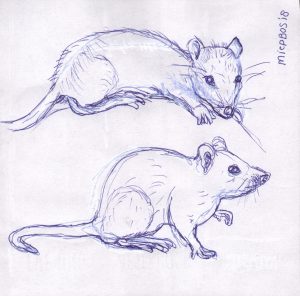Geplaatst op 12 juli 2018 door Miep Bos op Gentechvrij
Ratten die gevoerd zijn met gentechmais met 2 Bt variateiten en met glyfosaat resistentie ontwikkelden lekkende magen bij proefdieren.

Ratjes proefdieren (c) Miep Bos
Bespoten Gentech-mais met Glysofaten
Geplaatst op 12 juli 2018 door Miep Bos op Gentechvrij
Ratten die gevoerd zijn met gentechmais met 2 Bt variateiten en
met glyfosaat resistentie ontwikkelden lekkende magen bij proefdieren.

Ratjes proefdieren (c) Miep Bos
Quote: 09 July
2018, GM Watch :
Ratten die een half jaar gevoerd zijn met 2 Bt varateiten (die
resistentie geven tegen insecten en met glyfosaat resistentie)
ontwikkelden "magen die gaan lekken" volgens een Australisch onderzoek
Bovenstaande
link behelst het volledige onderzoek. De onderzoeken door de
multinationals zelf gedaan, worden steeds korter...
Korte impressie :
Histopathological
Investigation of the Stomach of Rats Fed a 60% Genetically
Modified Corn Diet
Affiliation(s)
1Discipline of Anatomy and Pathology, School of
Medicine, University of Adelaide, Australia.
2The Institute of Health and Environmental
Research (IHER), Kensington Park, Australia.
3Health and Environment, College of Science and
Engineering, Flinders University, Bedford Park, Australia.
Genetic
modification (GM) represents new opportunities for enhanced crop
features such as improved insect resistance and herbicide
tolerance. The technology allows for cross-species alterations,
therefore potentially allowing a vast array of novel traits.
Many GM crops have been developed and approved for human and
animal consumption. The present study investigated a
triple-stacked GM corn variety containing modifications for
insect resistance (via cry1Ab and cry3Bb1
genes) and herbicide tolerance (via an EPSPS gene), which was
fed to rats for six months. The study investigated the mucosa of
the stomach. Alterations to tight junction apposition, gland
dilatations with epithelial elongation and dysplasia in the
GM-fed rats were observed. These results indicate that GM-corn
may have an effect on rat stomach mucosa, which may have health
implications.
Leest
u het hele document even verder door, maar puntje 3 is een
interessant punt.
3.1. Animal Feeding
After randomisation, there was no difference between the body weights of the GM-fed and non-GM-fed groups. Over the next few weeks, it was noticed that the dietary intake of both groups of rats was not as high as expected and that the GM-fed rats were eating less than the non-GM-fed rats. Neither group of rats lost weight. The diet manufacturer suggested that the moisture content of the diets should be increased. The diets were therefore sent for repelleting, starting with the GM diet, because they were the group with the lowest dietary intake. The provision of moister diets resulted in a typical weight gain for the remainder of the study. Because the GM-fed rats were fed those diets a few weeks before non-GM-fed rats, they weighed more at the end of the study compared to non-GM-fed rats. Consequently, no conclusions can be drawn about the effect of the GM diet on body weight. Furthermore, because larger animals could be expected to have larger stomachs, the stomach weight was expressed as a proportion of body weight. The mean stomach weight to body weight ratio (and interquartile range) were 0.46 (0.44 - 0.50) and 0.43 (0.40 - 0.49) for non-GM and GM-fed rats respectively. The difference was not statistically significant.
Of importance, the total dietary intake over the course of the experiment indicates that the study has become more conservative in its findings, that is, any effects of the GM diet on the stomachs of rats has been underestimated. This is clarified in the discussion.
Er is ook sprake van afnemende vruchtbaarheid bij knaagdieren bij het langduriger gebruik van deze bespoten mais. Dit is hobby matige ervaring van verschillende knaagdierenfokkers over de jaren heen.
Copyright 2000 - 2025 by RR